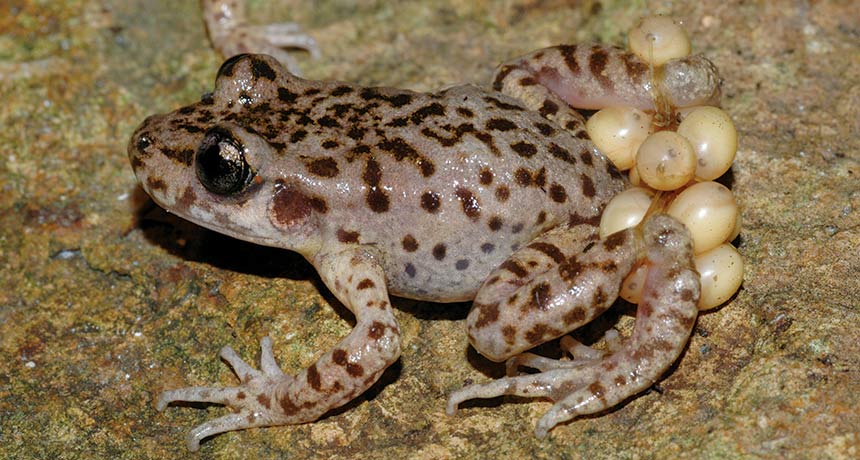Ponds and their toads cured of dreaded disease
Treating both the tadpoles and their habitat for Bd infection lets Spanish amphibians go wild again

MEDICINE FOR MIDWIVES Midwife toads on the island of Majorca have kicked the lethal Bd infection in the wild thanks to an experimental treatment.
Jaime Bosch
Doctoring whole ponds as well as the tadpoles living in them has turned a disease hot spot back into a healthy home for wild toads.
Majorcan midwife toads now flourish in mountain ponds once infected with the lethal chytrid fungus called Bd (for Batrachochytrium dendrobatidis), says Trent Garner of the Institute of Zoology in London. The fungus attacks more than 700 amphibian species on five continents, shriveling or wiping out susceptible populations and even snuffing out species.
Temporarily hospitalizing the wild tadpoles while dosing their ponds with disinfectant was the key to success, Garner, Jaime Bosch of the National Museum of Natural Sciences in Madrid and their colleagues have discovered. Four out of five ponds treated in 2013 on the Spanish island of Majorca have remained clear of any signs of Bd, the researchers report November 18 in Biology Letters.
Researchers have previously cured wild amphibians brought into labs with chytrid infections but then worried about sending the animals back to their fungus-infested habitats. The Panamanian golden frog, for instance, exists only in captivity because Bd has turned the toad’s habitat deadly.
“To the best of my knowledge, we are the first to have cleared infection in the wild,” Garner says.
Even before conservationists knew what Bd was, they worried about the survival of Majorca’s Alytes muletensis toads. But that concern had unintended consequences. This species of the midwife genus is native only to the one island. (The “midwives” are the dads protectively carrying fertilized eggs wound around their legs.) A well-intentioned effort to breed such a vulnerable species in captivity inadvertently allowed the killer fungus to hitchhike in with imported research animals.
The (sort of) good news was that the researchers could focus on just one amphibian, the toads, in the five mountain ponds with particularly bad fungus infestations.
Starting in 2009, the researchers tested ambitious strategies for beating the disease in the wild. First, researchers bushwhacked to the remote ponds — one required rope climbs up and down a cliff. Then they caught as many tadpoles as possible from infected ponds and carried them out in soda bottles rigged with portable aerators. To avoid afternoon heat at the most distant locations, researchers hiked in at night, napping on pondside stones until packing up the tadpoles at dawn for the hours of hiking back.
The first attempt at eliminating the disease failed. Researchers cured the captive tadpoles with the antifungal drug itraconazole but couldn’t get rid of the fungus. Bailing water out of the ponds and letting them scorch during the summer wasn’t enough. When the rainy season refilled the ponds, researchers helicoptered in the now-healthy tadpoles. But the tadpoles picked up the infection again. Older toads, so evasive they’re almost impossible to catch, probably kept the disease smoldering.
What finally worked was hauling out tadpoles again, draining the ponds and treating the area with a disinfectant called Virkon S that is used in laboratories. After months, the researchers returned the cured toad population. For more than two years now, four of the five ponds have had no infected tadpoles. The fifth pond is getting a second treatment.
This experiment shows proof of concept for making a locale safe for returning animals, Garner says. Different disinfectants may work better for other locations, he says, adding that other researchers are pursuing alternative ideas for fighting Bd.
How this labor-intensive project in island ponds with only one species to worry about might translate to mainland habitat with many amphibians remains to be seen, says herpetologist Joseph Mendelson III of Zoo Atlanta. Nonetheless he calls it “important work.”
Editor’s Note: This story was updated December 7, 2015, to correct the name of the Panamanian golden frog and the year the researchers began their efforts to eradicate Bd fungus from the ponds.







